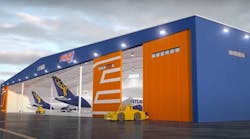It’s the indispensable ingredient to success in this business. If an MRO company has it, they can soar. If it doesn’t, sooner or later they’ll shut the hangar door.
AMT interviewed a quartet of leaders at a like number of successful MROs, people whose job it is to recognize talent and develop it. What we discovered is a common perception as to what makes for good leadership.
The Essential Skills
“We really hire for values and character — and, of course, someone with adequate technical knowledge,” says Greg Sahr, president of family owned, Moline, IL-based bizjet MRO Elliott Aviation. That last element — technical prowess — is important. Someone who’s worked their way up through the ranks is preferable. Such a path begets “understanding and empathy with the technician,” says Sahr. And that, in turn, breeds a special species of credibility that’s born from having been there and done that.
Sahr’s situation is pretty typical among MRO leaders of all ranks. He started off in the business as an avionics installation technician and worked his way up the ladder.
“We have people who started out with us as apprentice techs and are now managers and directors within the company,” says Amy Henrichsen, vice president people at Seattle-based Aviation Technical Services, one of the largest third-party transport category MROs in North America.
“It’s essential that [prospective leaders] have a good understanding of the technical aspects” of MRO, says Wayne Jamroz, vice president of operations for AAR Aircraft Services. Jamroz operates out of the giant MRO’s Rockford, IL, facility. “We traditionally bring the best technical people [in] and move them into leadership roles.”
While not discounting the importance of so-called ‘softer skills,’ Per Karlsson, director of maintenance for Teterboro, NJ-based Meridian Jet Center, says, “There are always core skills required to be a manager. But, you have to know what business you’re in.” That business is demanding, competitive, and regulated with a focused ferocity precious few others are.
Communication
Once a future leader possesses the right technical skills, other attributes come into play. Foremost among them is communication. It starts with communicating with technicians down on the hangar floor and in the back shops. “I spent quite a bit of time avionics trouble-shooting,” says Sahr. “When I’m speaking with customers, I can quickly connect with the technicians in the process and understand what the issue is. I think this helps considerably.” And not just in better communicating with technicians, but the manufacturer, the customer and other players as well. That meshing of technical understanding and communication skills helped leaders at Elliott Aviation recently install the first aftermarket Garmin G5000 cockpit upgrade package into the pointy end of a Beechjet/Hawker 400XP.
It’s the ability to speak multiple “languages” — customer, management, manufacturer, regulator — that sets an effective leader apart from the pack. “To be a leader within our organization is quite dynamic,” says AAR’s Jamroz. That dynamism is pegged in no small part to the ability to communicate with lots of different people with widely differing perspectives. “You’re not only working with the project, you’re working with your own employees on that project,” he says. “In addition to that you’re also working with customer representatives, technical representatives, quality representatives — as well as the customer headquarters folks, the vice president, the head of planning … So it’s got to be a very dynamic person to be able to handle [issues] and be able to talk, manage, and lead through the issues that pop up on a day-to-day basis.”
It all begins, however, with being able to communicate with line employees and leaders. Each morning at AAR “we have toolbox meetings,” says Jamroz. Safety and the issue of the day take center stage as people exchange information the way they have since time immemorial: face to face. How effective is this old-fashioned, eyeball-intensive approach? In part because of just this sort of initiative, the AAR Aircraft Services vice president says over the last four years safety has been such that worker compensation costs have plummeted 98 percent, a not inconsequential number— both in terms of employee safety and the bottom line.
Other Leadership Musts
Communication isn’t the only soft skill. Jamroz adds to that list “patience, tenacity, and the ability to think on your feet.” ATS' Henrichsen says “courage” is right up there too. “The way we define that is that [leaders] are willing to make hard decisions. Maybe not the [the most] popular one — but the right decision.” She says at ATS, “We look for people who have demonstrated courage throughout their career.”
Jamroz contends the MRO industry as a whole historically has not done a very good job in developing such non-technical leadership skills — including critical thinking, “people skills that are required to manage the people issues” that emerge virtually every day.
That’s changing however, changing as more and more companies across the aerospace spectrum realize that there’s more to managing than simply mastering your own particular technical discipline.
“We recently conducted a leadership training course utilizing Global Jet Services [for] 30 of our managers and leaders. It wasn’t a generic, off-the-shelf [affair],” says Elliott’s Greg Sahr. The course was driven by employee feedback. Elliott’s president calls the course “very, very targeted training for our leaders and managers across the business.”
Has it paid off? Sahr is emphatic: “Absolutely,” he asserts, “we’ve made tremendous headway with our managers and leaders, and with our overall culture.” He’s quick to caution that there’s no magic bullet, “no one training sessions that’s going to be the be-all, end-all … There are many things we are doing to create leaders within our organization.”
Over at ATS, Henrichsen says they’ve worked with outside consultants to mold their leadership training as well as developed their own. “Our philosophy is that our leaders will be provided leadership development training at least one time per year. We want to make sure that each leader has the opportunity to continue to develop.”
Not every MRO has got the girth to establish formal leadership training efforts. But that doesn’t necessarily mean an absence of leadership mentoring. The whole of Meridian, a well-respected aviation player, has some 250 employees. Per Karlsson says about a dozen of them work for him as technicians in the Jet Center’s repair station.
“You should always have some sort of [leadership] training. But we don’t have the formal training that some of these corporations have.” Instead, Karlsson keeps a keen eye out for talent. That means, “We start to try to groom them right away to become inspectors.”
Again, the preference at most MRO shops, be they global or family run, is to promote from within, to marinate the employee from the get-go in company culture.
“Everybody thinks they can go out and hire a good manager” from outside the company, says Jamroz. "They’re not as readily available as you might think.” That’s why “we’ve developed our leaders internally, so that we can promote from within. It’s taken several years to do that.”
Nothing is instant in MRO, especially developing the folks in whose hands you entrust the company’s fortunes.



